Nvidia: NVDA
Leading the AI Revolution
Nvidia has firmly established itself as a leader in the semiconductor industry, largely due to its dominance in the Artificial Intelligence (AI) space. AI is widely regarded as the most significant technological breakthrough of our time, with the potential to surpass even the internet in its impact on humanity. The markets are certainly pricing Nvidia accordingly, and this is only the beginning.
When analyzing any semiconductor company, it’s essential to start at the industry level. The VanEck Semiconductor ETF (SMH) tracks the 25 largest and most liquid U.S. exchange-listed semiconductor companies. By examining this ETF, we can gain insights into the sector’s overall performance and identify any industry-wide issues that could affect Nvidia.
Recognizing Market Cycles: Re-accumulation
The Shift from Mega Cap Tech to Interest Rate Sensitive Areas
Throughout the year, we’ve observed rotation out of the mega-cap tech sector into higher beta, interest rate-sensitive areas of the market. This shift has created numerous accumulation stages across various sectors, particularly those with stocks that have been beaten down but now present potential value.
This week, we return our focus on the leader of the AI bull market NVDA as we look into re-accumulation. By leveraging our exhaustive top-down analysis method, we aim to present clear evidence of how to recognize re-accumulation, what signs to look for, and how to profit from these situations.
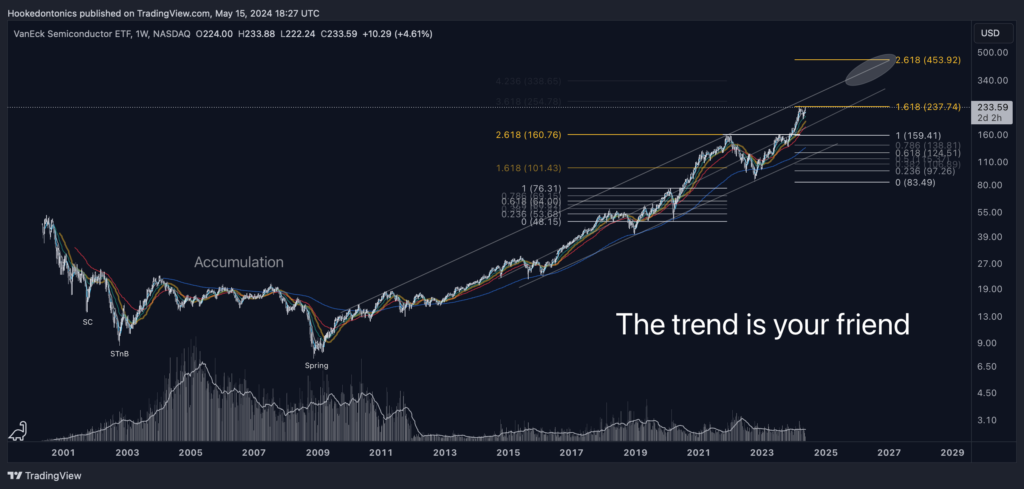
Weekly Chart Analysis: SMH
We’ll revisit the all-time weekly chart of the VanEck Semiconductor ETF, SMH, which we originally presented in our NVDA coverage in May. Back then, SMH was approaching an all-time resistance or supply line, within the range of the 1.618 Fibonacci extension from the COVID low. Since then, we’ve observed similar patterns in other mega-cap tech companies, with multiple examples of profit-taking.
This type of price behavior is normal and should be expected, as it’s how larger interests compound gains and sustain long-term bull markets. While some re-accumulation is occurring, the uptrend remains healthy, and we do not see signs of distribution at the sector level.
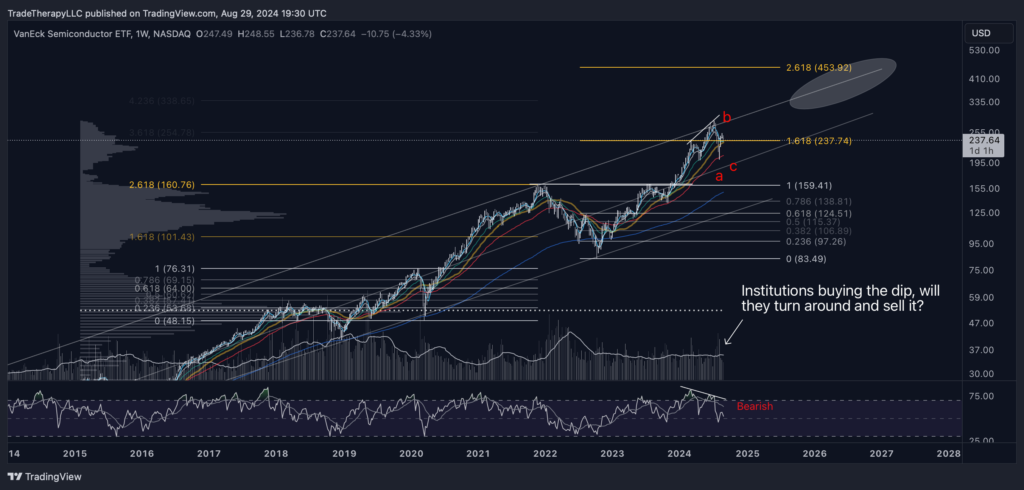
Zooming in on the weekly chart, we notice persistent bearish divergence—where the peaks of the Relative Strength Index (RSI) are declining while price peaks are rising. This indicates weakness and the potential for a reversal. Such ‘head fakes’ are common, and it’s important to note that the low of $199.15 from April was defended and held.
Our previous analysis on SMCI is still relevant:
“The spike in volume and subsequent up-thrusting price behavior indicates institutional buying. As we’ve been covering for several weeks now, we do expect there to be volatility over the next couple of months and this corrective (A,B,C) Elliott wave pattern is in line with these expectations. These rapid price advances are very appealing to retail investors that are endlessly seeking immediate returns. Financial institutions that are currently engaged in re-accumulation or compounding gains will often use these situations to sell or distribute into. We’ll be watching closely for a similar reversal candle formation over the coming weeks most likely in the $260-$270 range.”
Even if new highs are made in August, this does not invalidate the chart or the possibility of a retracement to complete wave c. The second wave of these formations could exceed the previous wave’s high. Stay vigilant and maintain a long-term mindset during high volatility.
As of this writing, SMH has not yet reached the $260-$270 range. We’ll see how much strength it shows as we move into October—a wick up into these levels remains a possibility.
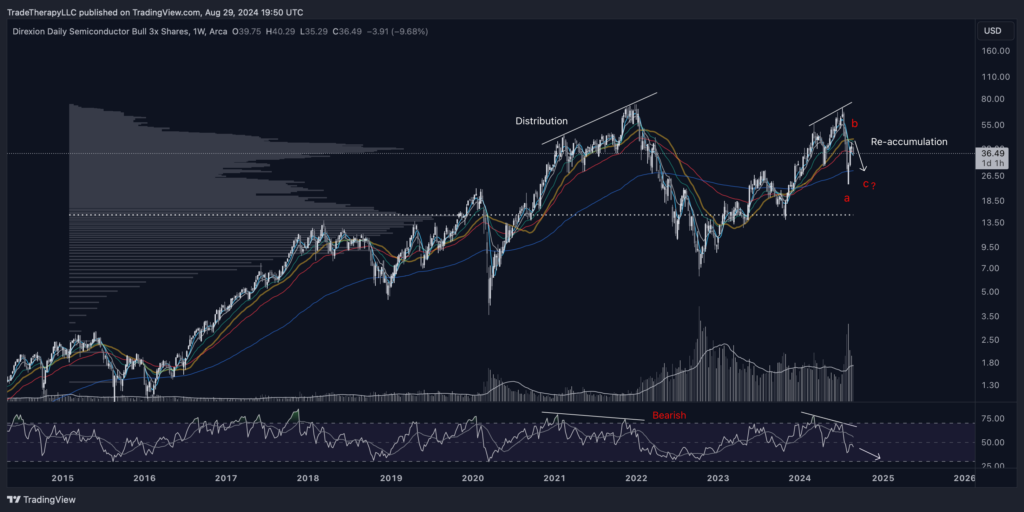
Weekly Chart Analysis: SOXL
The Direxion Daily Semiconductor Bull 3x Shares ETF (SOXL) has formed a pattern similar to SMH. It’s encountering overhead supply and forming a 3-wave corrective (ABC) structure. Such setups are common during re-accumulation periods, often producing symmetrical triangle patterns.
The negative divergence observed in SMH is also clearly present here. Leveraged ETFs like SOXL often exhibit textbook technical analysis setups due to their exaggerated behavior, making divergences easier to detect—an important component of our weight-of-evidence approach.
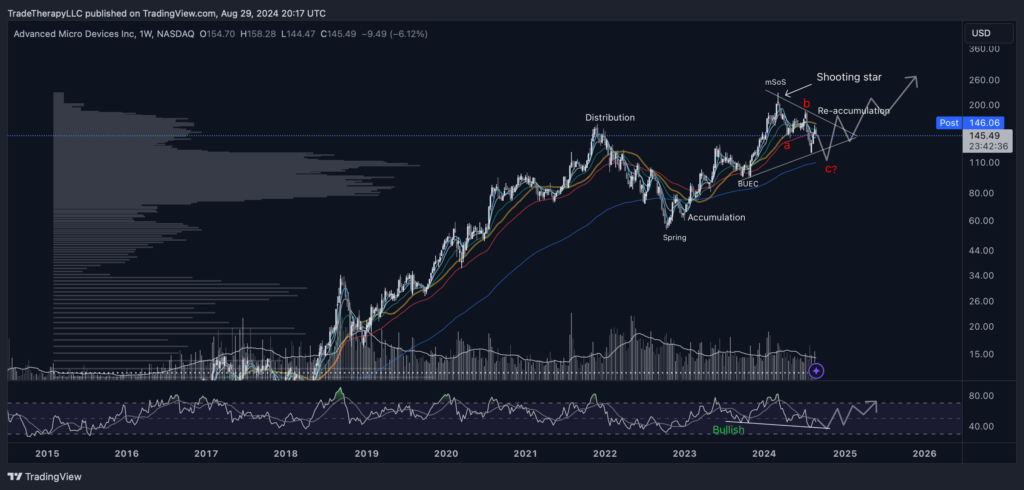
AMD: In Re-accumulation Phase
Although AMD is currently showing bullish divergence, it’s also in a re-accumulation phase. Several possible developments could unfold as the chart builds out, including the formation of an ascending triangle. Notice the potential spring event forming as we head into September/October. The weakness in sector ETFs makes this possibility more likely at this point.
Our analysis from our coverage on SMCI recently is still valid:
“The importance of understanding the strategy behind the process lies in determining if there is further downside risk. This is the same chart with an ABC Elliott count illustrating this process. Anyone notice anything odd about the volume here? Scroll up and look at the spike in volume in the SMH chart at the bottom of last week’s pullback. The one that says “Institutions buying the dip” with an arrow pointing at it. Take note that we don’t see a similar spike in either NVDA or AMD. This isn’t to say that SMH isn’t capable of producing a massive supply volume spike and sell off again. That’s one of the possibilities that needs to be considered. However, the data in front of us indicates that institutions just compounded in SMH which isn’t surprising for a sector ETF to bottom before the individual components. What this also tells us is that we may not have seen a bottom in AMD or NVDA.”

Weekly Analysis: TSM
Taiwan Semiconductor Manufacturing Company (TSM) shows the same bearish divergence seen across the sector, making the formation of a re-accumulation pattern highly probable.
In May, we watched to see if the 21-week exponential moving average (21WEMA) would provide support for the uptrend, but this has not been the case. Like the rest of the sector, TSM is cycling through its re-accumulation phase, testing the 55WEMA (red). We expect it to retest this level again.
Strategic Re-accumulation by Wall Street
Wall Street conducts re-accumulation phases where they can maximize returns on their investments. These phases aren’t cheap, requiring months of planning, positioning, and marketing. The decision to re-accumulate now suggests that financial institutions see strengthening uptrend conditions and want to increase their holdings while prices are still low.
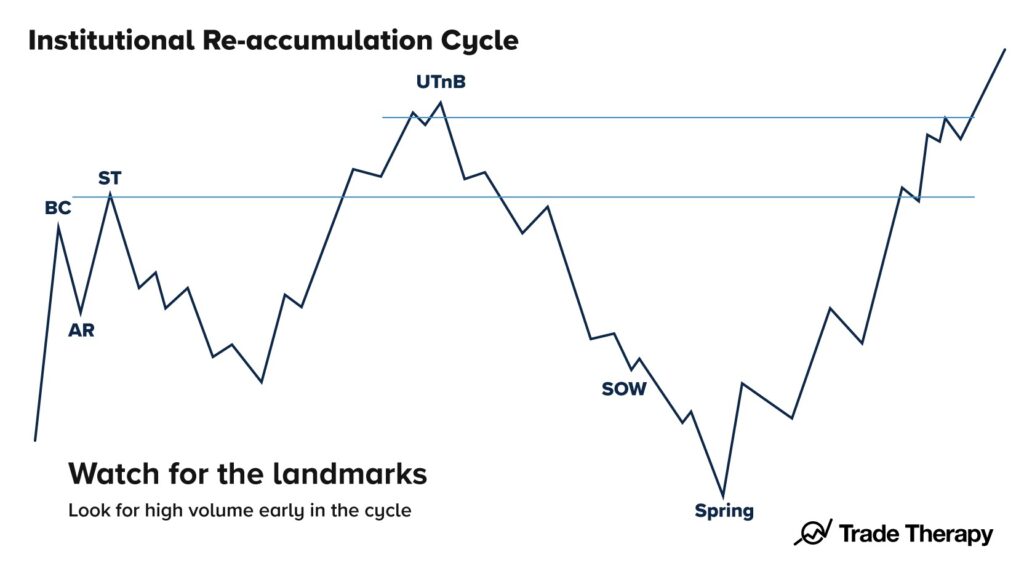
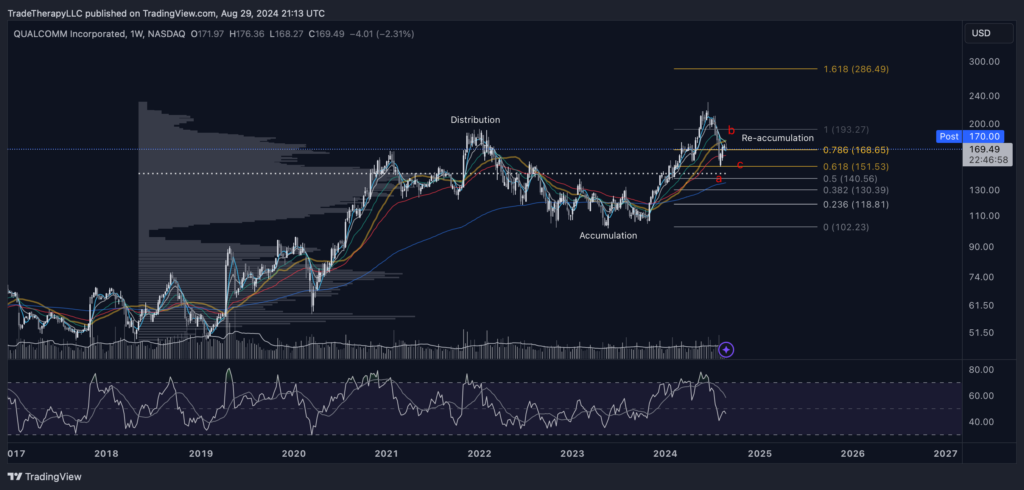
This is our first look at QCOM since our May coverage of NVDA, where we observed:
“No surprises here as QCOM is at the top of its accumulation range and set a new all-time high close this week. This has yet to backtest the 30WEMA and is looking slightly extended relative to the longer weekly moving averages.”
QCOM couldn’t hold its moving average cluster as backtests failed, but it bounced off the pivot at $150 and is the only chart we reviewed this week that isn’t showing bearish divergence.
It’s still possible that the $150 level could be retested. During volatile stages, it’s crucial to stay focused on the long-term view, as we’ll experience violent shakeouts while institutions rebuild their positions—signs that the trend has changed, and market dynamics are shifting.
NVDA: Riding the AI Wave

Nvidia, the AI darling, continues to perform well. We’re monitoring short-term moving averages for a potential crossover, but the low volume doesn’t suggest a bottom is in yet. We’re watching for demand to come in on volume, with a possible ‘c’ wave in the corrective formation.
We’ve noted several times this year that NVDA is in a range where profit-taking should be expected. Now, it’s time for larger interests to re-acquire their positions.
During the most recent reporting period, it became public that Michael Burry was heavily exposed to China—an example of rotation into higher risk. Many had moved out of NVDA, which is common during re-accumulation.
NVDA posted strong earnings numbers, but as we’ve emphasized, larger interests aren’t focused on this quarter’s earnings. Yes, it’s important that NVDA continues to grow and make money, but the price behavior is being dictated by institutional profit-taking.

2022 Chart Analysis: NVDA
Our chart from August 2022 identified our target range for re-entry, based on the bear flag, falling peaks, and supply zone that drove prices lower. The high volume, predominantly red, confirmed our analysis.
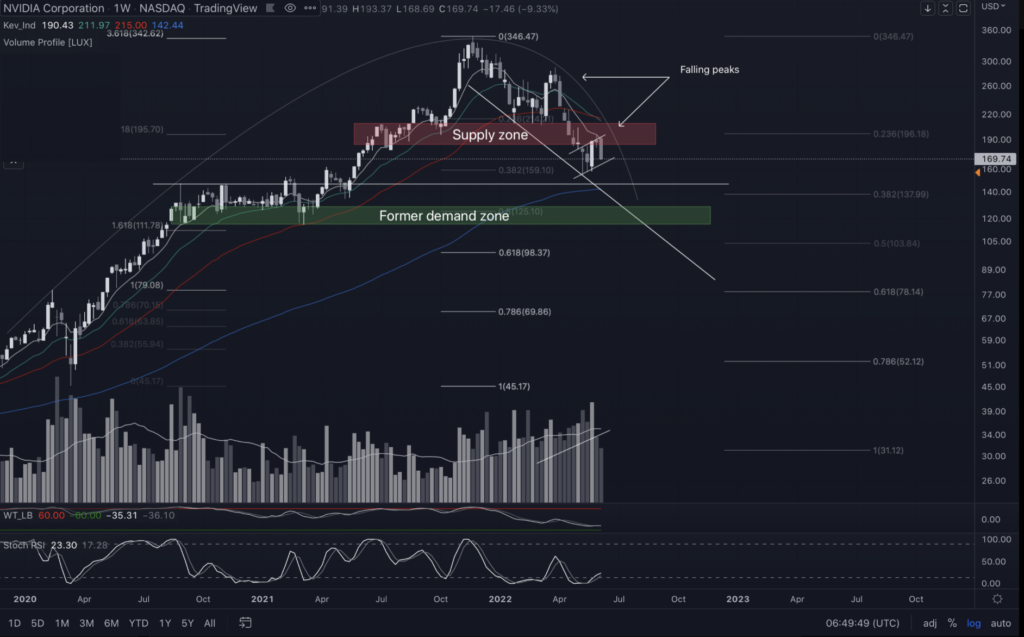
Here’s how it looked then, with the convergence of the main downtrend line and the bottom of the former demand zone. This is where NVDA eventually bottomed in October 2022.
This is the trade that is taking profits currently. Financial institutions that took the long side of NVDA at the bottom went on a blistering run over the next 19 months.
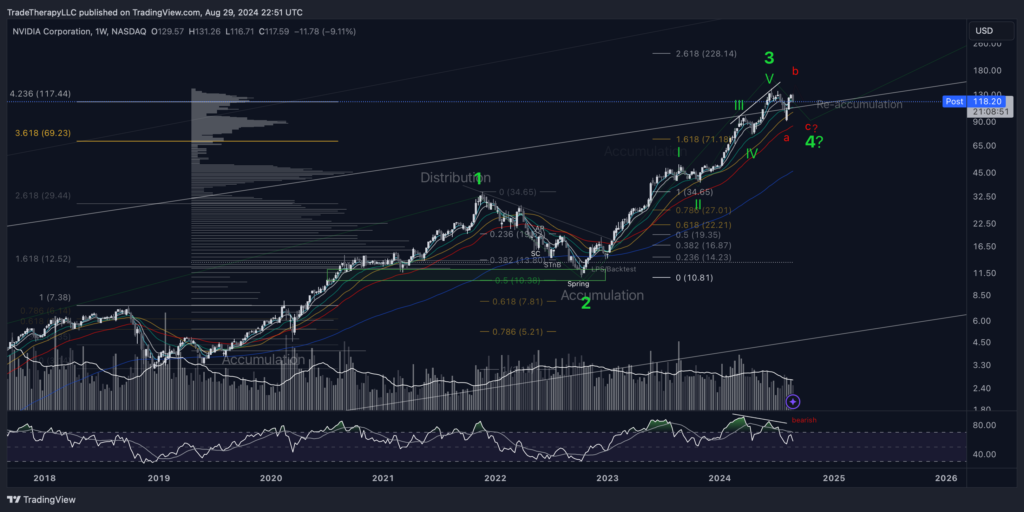
NVDA’s Current Position: Range-bound and Waiting
NVDA is likely range-bound, possibly forming an ascending triangle pattern—a common continuation pattern during re-accumulation periods. On the higher time frame view (above), the COVID low is an almost perfect 50% retracement of the previous run coming .41c short. This is another commonly used method to determine downside targets. Inverting a fibonacci extension into a retracement using the beginning of the last uptrend to the top (0=top, 1=bottom) provides the .5 fibonacci level. This was also part of our determination process when we identified our target entry range in Aug.‘22.
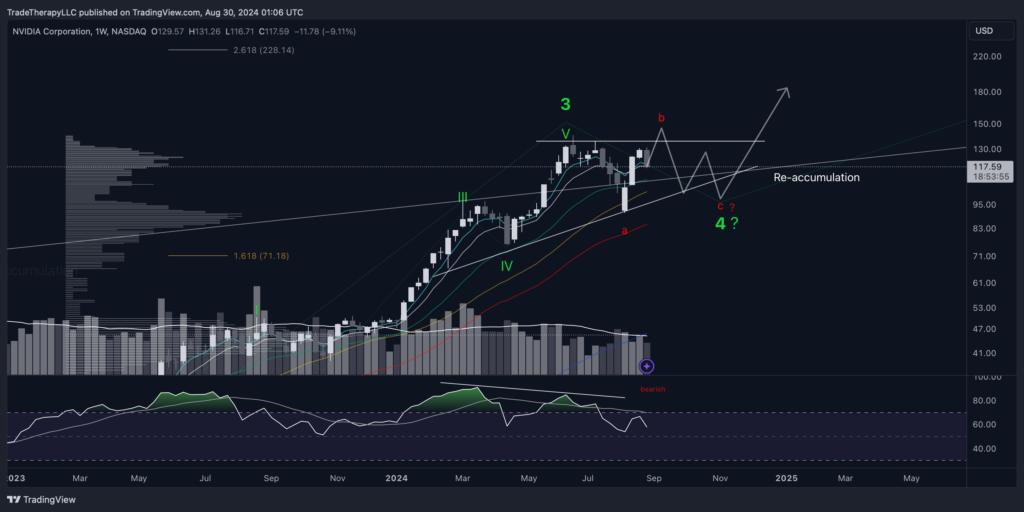
Zooming into the present, NVDA is rejecting resistance near all-time highs. Our speculative path accounts for a head fake breakout in September and a false breakdown as we approach the Presidential election in November.
NVDA should have a long, profitable uptrend coming out of this seasonally volatile period. We’re expecting Wall Street to use every trick in the book to acquire as many shares as possible. That scenario most likely includes luring retail investors in by pushing price higher mimicking a breakout to new highs and then pushing them out by mimicking a breakdown.
One thing is clear, the entire semiconductor space is showing weakness including NVDA.
Summary: NVDA’s Future Looks Bright but Volatile
Despite a strong earnings report, NVDA is closing the week down almost 7%. All evidence suggests that the re-accumulation process we identified in May is continuing. The entire semiconductor sector shows similar patterns and technical indicator readings, such as bearish divergence. Seeing the same signals across the sector, leaders, and competitors’ charts is a strong signal.
This week’s top-down analysis leads us to conclude that while NVDA will likely be a leading stock in the next cycle, it’s currently experiencing weakness as larger interests take profits and prepare to re-acquire positions at lower prices. This process will likely involve significant volatility and dramatic price swings in both directions.
Knowing we’re in a re-accumulation phase, not a distribution phase, is crucial. This insight allows us to seek long entries as prices retreat, targeting the local low around $85 (with the previous low at $83.27). We’ll begin taking long positions as the price approaches this level, watching for a Wyckoff spring to develop.
Long-term Outlook: Bullish on NVDA
NVDA’s long-term outlook is very promising, and we’re bullish on it as a long-term hold.
Bullish Scenario: Upcoming rate cuts have an immediate impact on market valuations and buyers push NVDA to all time highs. The previous ‘yen carry’ low turns out to be an abbreviated re-accumulation phase. Previous highs convert from resistance to support as the uptrend continues.
Bearish Scenario (Primary expectation): Seasonal volatility increases as we move closer to election time. Though we may see a new all time high, it is short lived as supply > demand conditions produce a breakdown pushing prices much lower. The previous low at $83.27 is tested and temporarily fails.
Trade Considerations
Based on this week’s research, several trading opportunities are under consideration:
- SMH: We were expecting to see some of the inefficiencies created by the ‘yen carry’ drop to create a long trade. It has and it remains to be seen if wave b or this corrective wave is complete. We would consider a starter short trade at these levels adding on any up days. Wave c aligns well with seasonal volatility. Our stop would be placed just above $260 (above last weeks high). If we were positioned long via common shares, we would be hedging and financing it by selling calls. Otherwise, we’ll wait for new all time highs to enter long.
- SOXL: Clear ABC corrective wave forming. We would have a starter short here trading the C wave down. There is a scenario where a push higher over the next week or two may be used to draw in liquidity. Should this occur, we would scale into our short position with a high set over the most recent high.
- AMD, QCOM, TSM: All of these are in an almost identical position to SOXL and SMH. We would consider trading all of them in the same manner as SMH and SOXL above.
- NVDA: Two weeks ago in our spotlight on SMCI, we indicated we were expecting a reversal and got it. Heading into earnings when expectations were high for another push higher we saw the weakness in the market structure. Although the numbers were good, NVDA sold off. If we were in this trade, we would have taken a starter short trade earlier this week. We would manage the trade as described in the Bearish Scenario above. Our stop would be placed just above last week’s high.
Final Thoughts
The first week after the change in monetary policy announcement was volatile as expected. The rotation out of mega cap tech stocks into higher beta, risk assets continues. Many of our accumulation charts that we’ve featured this year are breaking out. All of the yield curve charts are confirming normalization indicating the bull cycle in interest rate sensitive areas of the markets are moving into the next phase of their new uptrends. Hopefully, everyone is well positioned to generate profits. The returns that will be generated in this next cycle can change people’s lives when managed properly.
We’ve recorded 2.5 hours of video content, currently being edited and soon to be posted. This new medium will enhance our members’ experience, adding value through live chart reviews. Stay tuned.
Lastly, we set a stop for MARA at $16.60, expecting a test of $17. It hit $16.49 and is at $16.76 after hours. When a stop is hit and the price immediately reverses, consider re-entering with the same stop or slightly lower. If the trade moves as analyzed, re-entry is advisable, as it indicates alignment with institutional levels.
Seasonal volatility can be managed through hedging and maintaining a long-term perspective.
Disclaimer: Trade Therapy, L.L.C. content is intended for US recipients only and is not directed at UK recipients. Our information and analysis do not constitute an offer or solicitation to buy any security and are not intended as investment advice. Content should be used alongside thorough due diligence and other sources. Opinions and analyses are those of the author at the time of publication and may change without notice. Trade Therapy, L.L.C. and its employees may move in or out of any trades detailed within our content at any time at their discretion. Employees and affiliates of companies mentioned may be customers of Trade Therapy, L.L.C. We strive for transparency and independence, and we believe our material does not present a conflict of interest. All content is for educational purposes only.


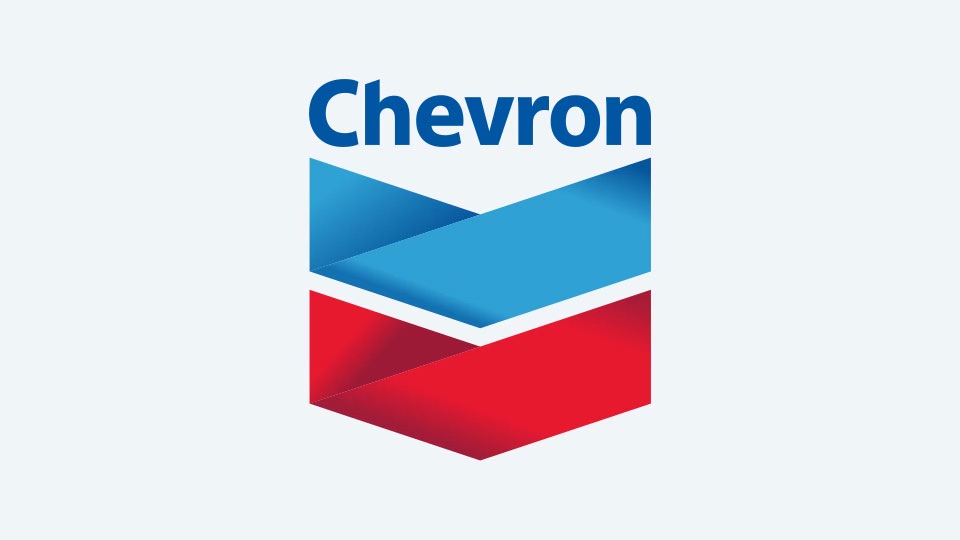


Leave a Comment
You must be logged in to post a comment.